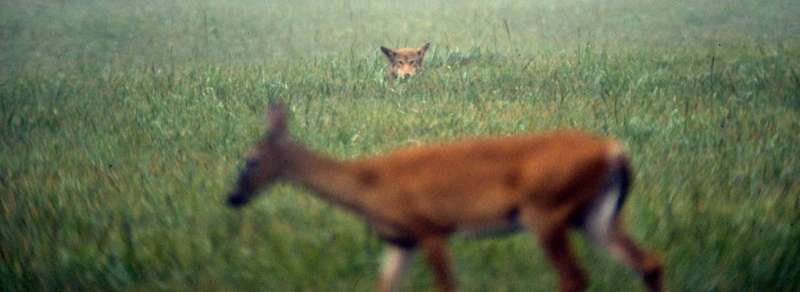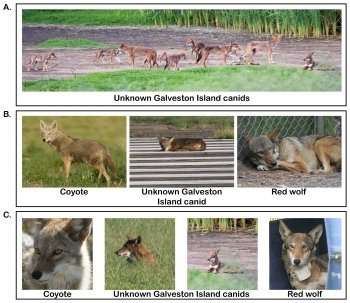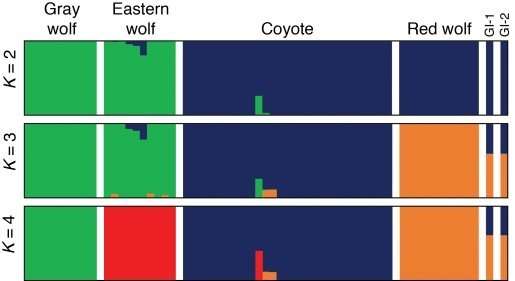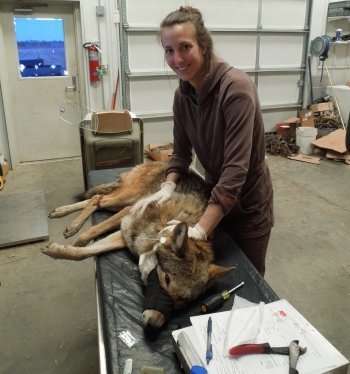A red wolf watching deer at Cades Cove in the Great Smoky Mountains. Image Credit: B. Crawford/USFWS, 2004
Red wolves, once nearly extinct, again teeter on the abyss. New research finds red wolf ancestry on Galveston Island—providing opportunities for additional conservation action and difficult policy challenges.
The American red wolf is one of United States' greatest wildlife conservation stories. Red wolves were on the brink of extinction along the American Gulf Coast during the late 1970s when the U.S. Fish and Wildlife Service (USFWS) made a bold decision to purposely remove all remaining red wolves from the wild.
The USFWS attempted to trap all wild wolves to initiative a captive breeding program and recover the species. After several years of successful captive breeding, red wolves were released back onto the landscape in North Carolina in 1988, well before the famous wolf reintroduction effort in Yellowstone National Park.
The reintroduced population in North Carolina grew for 25 years, even while experiencing complex management issues such as red wolves hybridizing with coyotes.
But the wild population is once again dwindling (from a peak of about 150 individuals in the wild in 2005 to a mere 30 or 40), amongst political controversy and pressure from a number of landowners to be able to shoot the wolves on their land.
In addition to the wild population, there are approximately 200 red wolves in captivity.
Photographic comparison of coyotes, Galveston Island (GI) canids, and red wolves. Credit: Michigan Technological University
The entire red wolf population descends from 14 individual animals, of which only 12 are genetically represented.
Ghost Alleles
During this ongoing debate of how to recover the red wolf, a team of researchers including Michigan Technological University scientist Kristin Brzeski, assistant professor in the School of Forest Resources and Environmental Science, discovered high amounts of red wolf ancestry in canids living on Galveston Island in southeast Texas.
"Our discovery that red wolf genes have persisted in Texas—after being declared extinct in the wild—was very surprising," Brzeski said. "It introduces both positive opportunities for additional conservation action and difficult policy challenges."
Brzeski and her coauthors published their findings, "Rediscovery of Red Wolf Ghost Alleles in a Canid Population Along the American Gulf Coast" Dec. 10, 2018 in the journal Genes.
Genetic analysis depicts genetic assignment of gray wolves, coyotes, red wolves and the admixed canids on Galveston Island (shown here as GI-1 and GI-2). The analysis reveals that while the Galveston Island canids do not share all alleles with red wolves, they are more genetically similar to red wolves than to coyotes. Credit: Michigan Technological University
Canis Rufus
There are just two recognized species of wolf in the United States: the gray and the red. Red wolves are smaller and slenderer than their northern cousins, and are native to the southeastern U.S. The small red wolf population has also been under threat from hybridization with coyotes.
"Red wolf research is exciting, frustrating, sad and uplifting all at the same time," Brzeski said. "They have neared total extinction, were saved through captive breeding and have been demonized by opponents—all the while continuing to be a successful, reproductively viable species that keeps on ticking, with the help of incredibly dedicated biologists, managers, captive facilities and dedicated volunteers, of course."
The red wolf alleles—variant forms of a given gene—appear to have persisted in a population of canids on Galveston Island, likely because of their isolation from coyotes and therefore low probability of interbreeding and hybridization.
The researchers obtained tissue samples from two roadkill canids on Galveston Island and conducted analyses with genome-wide single nucleotide polymorphism and mitochondrial DNA from 60 animals that represented all potential sources of ancestry for the Galveston Island canids: coyotes, red wolves and gray wolves. Brzeski and others found that the Galveston Island canids have both red wolf and coyote alleles, likely related to species interbreeding during the 1970s as coyote populations expanded across North America.
The Galveston Island animals—known as admixed canids—do not share all alleles with contemporary red wolves, but they are genetically closer to red wolves than they are to coyotes.
Kristin Brzeski examines a red wolf for ectoparasites as part of a 2015 disease study on red wolves and coyotes in North Carolina. Credit: Michigan Technological University
This is significant because it means that red wolf genetics persist in the American south nearly 40 years after the species was thought to have become entirely extinct from that region. The population of canids on Galveston Island could represent a reservoir of red wolf genes that could be used to bolster other red wolves.
"This research shows hybrids can have conservation value through harboring extinct genes from endangered parent species," Brzeski said.
Next Steps
The research reveals the need for further genetic sampling of coyote populations in Louisiana and Texas to survey for red wolf ghost alleles. Additionally, the researchers note a need for assessments of morphological differences in canids with red wolf ancestry. The discovery of the Galveston Island canids could also create an opportunity for future reintroduction efforts outside of North Carolina.
"Our discovery opens up a new chapter in their story: red wolf ancestry has persisted independently without focused management action. How will this impact recovery efforts? Can we recover extinct genes through selective breeding with newly identified admixed canids? Are these individuals legally listable under the Endangered Species Act?" Brzeski said. "These are all difficult but exciting questions that are broadly important beyond red wolves that will influence wildlife conservation in an era of major climate and landscape change."
More information: Elizabeth Heppenheimer et al. Rediscovery of Red Wolf Ghost Alleles in a Canid Population Along the American Gulf Coast, Genes (2018). DOI: 10.3390/genes9120618
Provided by Michigan Technological University

























